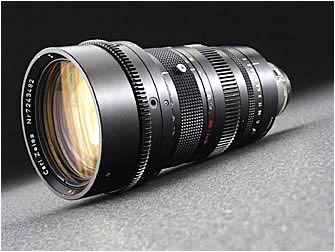-
Posts
2,247 -
Joined
-
Last visited
About Will Montgomery

Profile Information
-
Occupation
Producer
-
Location
Dallas, TX
Recent Profile Visitors
-
Scoopics are usually less noisy than a Bolex and they are the fastest loading cameras around...but they do make some noise and some are louder than others. What about an A-minima?
-
Good question...In the still world, Panatomic X was the first X film in 1938. Then Plus-X, Super-X, Super-XX, Ortho-X & Tri-X. So there's a long tradition of X films just not sure where the original X came from. Xtra? Probably need a Kodak historian to let us know.
-
Sorry I just saw this! Scoopic MS lets you add a 400' magazine if you can find the adapter so I usually recommend that but I've had an M, MN & MS and they all shoot the same as far as I can tell so if you get a good deal on any of them...go for it. I look at Scoopics as having the ease and convenience of Super 8 if you want...even the loading is the easier in any non-cartridge 16mm camera...but you can turn off the autoexposure and use your own meter as you want. The lens is just great. I have seen them removed from Scoopics and mounts put on them for use in other cameras actually. Best part of a Scoopic is not having to constantly wind the camera. Can't tell you how that would hurt my hand after a half day of shooting. Then the autoloading and autoexposure are close seconds. It all adds up to ACTUALLY USING THE CAMERA more. If you're shooting a feature then grab an Arri SR2 or 3 but for music videos, home movies and fun can't beat a Scoopic.
-
The Scoopic lens is really amazing...I've had colorists ask me what lens I was using because it was so sharp. The whole "zoom in for critical focus" is very easy with a Scoopic as well which helps. Very easy and efficient camera...especially for loading.
-

Is it possible to loop a super 8 film on a video editor?
Will Montgomery replied to Clare West's topic in Super-8
Back in the day we used to use mic stands to create audio tape loops...make the loop and pull a mic stand out to hold the loop's shape and size. Not sure if that would work with film...even a nice clean stainless steel mic stand might scratch film so some sort of roller system would probably be best. -
I've had lots of film scanned on a Shadow. In the hands of a skilled colorist, it does a great job. But as mentioned all those machines are insane to maintain and suck an ungodly amount of electricity. Shops would fly in techs to make adjustments and pay crazy amounts of money. But back in the day these machines MADE lots of money since most decent commercial projects were shot on film. Not the kind of thing you want in your house for personal projects unfortunately.
-

Are regular 16mm cameras worth investing in?
Will Montgomery replied to Brett Allbritton's topic in 16mm
Also keep in mind that modern film stocks are designed NOT to show a ton of grain if properly exposed...even 500T; especially in 35mm. For many years Kodak was pouring millions in research dollars into reducing grain and perfecting color. Now in 16mm we love some grain...but just enough to remind people that it's film. ? -
I believe Visual Products was successful at making one Scoopic MS Super 16. It was ridiculously complicated, expensive and time consuming to do and I don't think it made sense to do for anyone else. It was on sale on eBay like 6 years ago maybe? I remember seeing it clearly because I'd always heard it was impossible. Ultra 16 all day long...no need to recenter the lens.
-

US$47 standard/super 8mm telecine?
Will Montgomery replied to Keith Walters's topic in Post Production
Yep, it's the Wolverine. Maybe at $47 it's worth it?? Maybe not. It will just make you mad at how crappy it is. -

Are regular 16mm cameras worth investing in?
Will Montgomery replied to Brett Allbritton's topic in 16mm
Thanks Raymond. There was no grain reduction...just exposed properly on a sunny day with low speed stocks. Between the Spirit and Resolve it was definitely color corrected in transfer of course. If you want grain there's always 500T and my favorite B&W Double X! -

Are regular 16mm cameras worth investing in?
Will Montgomery replied to Brett Allbritton's topic in 16mm
Here's something shot on an Arri SR1 standard 16mm. I left it as standard format but I could have had it scanned to 16:9 with no grain problem. Don't remember the stock but it was probably 50D or 100t. Lens was a Zeiss 10-100 T2. Scanned to HD on a Spirit with a good colorist. Some of it is a little shaky as I was getting used to shoulder shooting when zoomed in. I would say if you get a good deal on an SR1 standard go for it. Super 16mm is more practical but not at double the cost unless you're a professional and that's a requirement. -

What is verdict on Cintel 2 scanner for 16mm?
Will Montgomery replied to Daniel D. Teoli Jr.'s topic in Post Production
No, I see it too. It's not the transfer, it's the camera. I used to call it the "K3 Flutter" and sometimes I got it on the Canon Scoopic. A camera tech will probably define the issue better...on pro cameras it can be adjusted but there's simply not enough control of the film path on an inexpensive 16mm camera to get rid of it. At least that was what I was told. ? -

WWII cameras Eyemo Askania and Arriflex 35 test shots now
Will Montgomery replied to Stanislav Schubert's topic in 35mm
That was processed by a lab that no longer exists out of Seattle I believe. Just a wind-up old Eyemo with Double-X negative. Scanned on a Spirit Telecine.- 12 replies
-
- 35mm
- moviecamera
-
(and 3 more)
Tagged with:
-

WWII cameras Eyemo Askania and Arriflex 35 test shots now
Will Montgomery replied to Stanislav Schubert's topic in 35mm
Great shots. Fun that these cameras can still make wonderful images all these years later...I still love using my Eyemo whenever I can. And they would make great weapons in war too...heavy steel! https://vimeo.com/16430701- 12 replies
-
- 35mm
- moviecamera
-
(and 3 more)
Tagged with:
-
A plus for Visual Products is that they still have a tech on staff that can service these cameras; something of a dying art. They may have slightly inflated prices on used gear but they are reliable and stand by what they sell. Remember when purchasing that you'll have to regularly service the camera and need to develop a relationship with someone who can do it and get parts. In the U.S. it seems to be easier to get Arri SR parts than Aaton LTR parts which may be another consideration. Last time I checked, Arri NY would still service SR2's and 3's although maybe not officially...there was a tech there single handedly trying to keep those cameras alive. Another resource for techs is Panavision but they won't officially help you as they don't service cameras they don't own, but they have the knowledge and often parts and may take pity on you if you walk in with puppy dog eyes.







